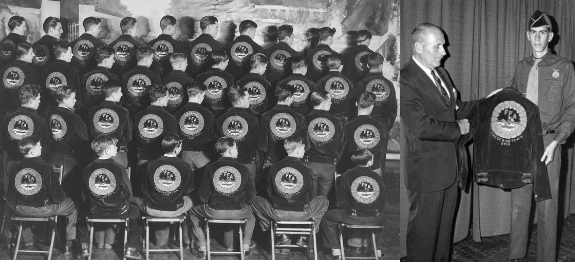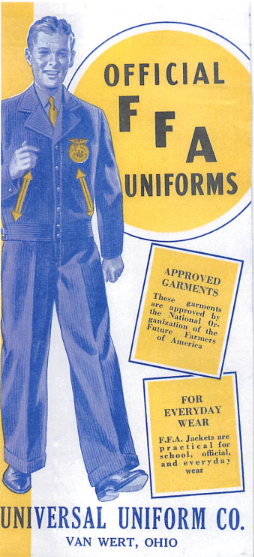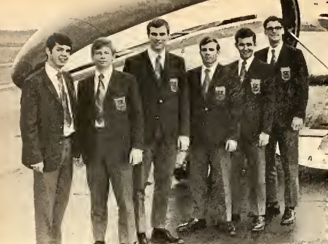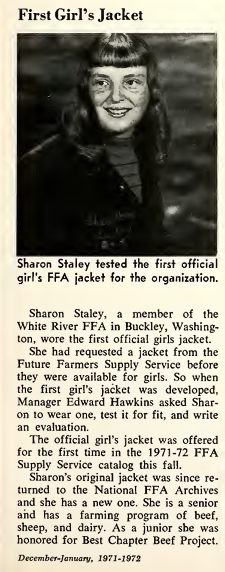In the world of computers, a major upgrade to a software program receives a new number such as going from Windows 10 to Windows 11. In this Friday Footnote we will use that approach in exploring the evolution of the FFA Jacket.
We start with FFA Jacket 1.0 in 1933. During the next 30+ years there were incremental changes to the Jacket (1.1, 1.2, etc.). We entered the era of Jacket 2.0 in the 1950s. There were subtle changes at first then the idea of FFA blazers and the admittance of females to membership in the FFA brought about additional changes.
The 1990s ushered in the FFA Jacket 3.0 era. There was a major initiative to restore the original colors to the emblem and to the jacket. It was time for another overhaul of the fit of the jacket. And the decision to outsource the jacket to Viet Nam was controversial to say the least. There is not enough space in this Footnote to discuss all three eras – so Jacket 3.0 will be the subject of next week’s Footnote.
The co-author of this Footnote is David Laatsch, a retired agriculture teacher in Wisconsin. I consider him to be the leading authority in the world on FFA jackets. He is putting the finishing touches on A Collector’s Guide to FFA Memorabilia. This comprehensive 160+ page book on everything FFA should be rolling off the presses this summer. You will definitely want to purchase a copy when it becomes available. Details will be available in the Friday Footnote.
FFA Jacket 1.0
Two weeks ago Dr. Connors from the University of Idaho started this ball rolling by describing the origins of the FFA jacket. L. H. “Gus” Lintner, the agriculture teacher in Fredericktown, Ohio, after seeing a corduroy jacket on display in a store window, contacted the company that made the jacket, the Universal Uniform Company in Van Wert, Ohio to see if they could produce jackets for his FFA band. They were going to perform at the National FFA Convention in Kansas City in 1933.

Figure 1. Left – The Fredericktown Ohio FFA members modeling the 1.0 Version of the FFA Jacket.
Right – Gus Lintner, the originator of the FFA jacket.
The jacket produced by the Universal Uniform Company was a big hit at the FFA convention and was soon adopted by the FFA as the official jacket.
It is a surprise to some people to learn that over time different companies have manufactured “Official” FFA jackets (and some companies have manufactured FFA jackets that were not sanctioned by the National FFA). The Universal Uniform Company of Van Wert, Ohio produced the first FFA jackets and was/has been a major supplier of FFA jackets for decades. Before the FFA Supply Service started to operate in February of 1948, jackets would be ordered directly from the manufacturer.

Figure 2. A 1930 era brochure for the Universal Uniform Company.
Some differences between the jacket of today (3.0) and the earlier versions (1.0) are:
- Vintage jackets had snaps instead of zippers. Prior to 1946 most jackets had snaps. Jackets produced as late as 1950 had snaps on the sleeves instead of buttons.
- Prior to 1946 the emblem on the back of the jacket was embroidered rather than sewn on patch emblems. Later they were heat glued on.
- There were square pockets instead of rounded.
- Some jackets manufactured between 1938 and 1942 had yellow “darts” or “arrows” on the pocket. A few jackets were made with navy blue darts.
- The wording on the FFA emblems said “Vocational Agriculture” instead of “Agricultural Education.”

Figure 3. FFA Jacket 1.0 from 1943. Notice the snaps instead of a zipper and the arrows on the pockets.
This jacket was manufactured by Universal.
At the January 1948 Board of Directors meeting a motion was passed requiring zippers on official FFA Jackets.
FFA Jacket 2.0
A second supplier of official FFA jackets was allowed in the early 1950s — the Ringer St. Croix Company in Minnesota. In 1952 Ringer produced 42,000 jackets while Universal made 12,000 jackets.
During the 1950s and 1960s there were some subtle changes to the FFA jacket. At the January 1953 FFA Board of Directors meeting a lengthy discussion was held comparing “vat dye” versus “sulfa dye” in producing the corduroy material used in the jacket. The sulfa dye tends to fade over time and wears off on white shirts. Even though vat dying is more expensive the decision was made to move to vat dyeing.
At the July 1957 Board meeting it was pointed out that the two companies (Universal and Ringer) making FFA jackets had two different styles of lettering on the jackets. It was decided the Universal Uniform lettering be the standard style of lettering for FFA jackets.
At some point in time, Ringer ceased to make FFA jackets. In 1959 both Universal and Ringer were awarded three year contracts with an option for two additional years. After 1959 there is no mention of Ringer in FFA Board Minutes.
At the July 1962 Board meeting, Mr. Damish (state supervisor in Illinois) shared a comment from one of his teachers that some of the jackets did not measure up in quality.
The 1960’s was an era of change for all aspects of American life and FFA was no different! Rejection of traditions and a look toward a new and modern look led to the FFA Supply Service to make some changes.
In 1964 the Board discussed and authorized the production of an “Official FFA Blazer” to be worn by national FFA officers on special occasions. Later (1969) these blazers were made available through the Supply Service to any person ordering one.

Figure 4. Figure Blazers worn by the national FFA officers.
In January of 1966, Mr. Hawkins, the manager of the FFA Supply Service, asked the FFA Board for guidance. The Supply Service was receiving about 50 orders a year for jackets for females. This was several years before females were allowed membership in the National FFA. Some states and some local chapters were allowing females to be in the FFA. A motion was passed to sell the official jacket to all “bonafide FFA chapter members.” But the minutes of the board meeting did not define bonafide!
At the January 1969 FFA Board meeting, Mr. Hawkins, the manager of the FFA Supply Service discussed the need to update and modernize the FFA jacket. He displayed a new jacket which fit better through the shoulders and asked for the Board’s opinion. Mr. Hawkins was authorized to modify the design of the official FFA Jacket.
Did the decision to allow females to become members of the National FFA in the fall of 1969 have an additional impact on the design of the jacket? No, not immediately. The ladies ordered boy’s jackets and modified them to fit. Typically the jackets were too long and too wide in the torso. Also the sleeves were too long and had to be rolled up or tailored.
At the National FFA Convention in 1970 the National FFA Supply Service Committee recommended the FFA move forward with developing a blue corduroy FFA jacket for female members. The Board of Directors accepted this recommendation at their January 1971 meeting and authorized the director of the Supply Service to make jackets AND blazers in sizes to fit girls. The first FFA jackets tailored for females occurred later in 1971. Sharon Staley (see below) was the first to receive a jacket designed for female FFA members.

Figure 5. Article from the December-January 1971-72 issue of the The National Future Farmer Magazine.
In January of 1985 the FFA Board of Directors appointed a committee consisting of two national FFA officers and two other persons appointed by Dr. Case to investigate the current price and quality of the FFA jacket. The report of the committee was accepted. However, the minutes of the meeting do not contain details of the report. But we have some idea of the gist of the report since a motion was passed directing the Supply Service director to “actively pursue alternative suppliers of jackets in order to create a competitive contractual setting.”
In 1989, twenty years after the 1969 jacket update and modernization, the FFA Merchandise Center (formerly the FFA Supply Service) asked the North Carolina State University Textile Department to redesign the fit of the jacket in order to accommodate the body shape of today’s students. Apparently, the body shape of students had changed over 20 years.
There was high drama regarding the FFA jacket in 1989-1990; the Universal Uniform Company, the longtime supplier of the jacket filed for bankruptcy. The DVB Company on the outskirts of Kansas City received a three year contract to supply jackets (starting in September of 1990). Four companies had submitted bids. An article shedding light on these events appeared in the Kansas City Star on November 9, 1992. The article contained an interview with Bernie Staller, the Chief Operating Officer of the FFA:
“What our kids have wanted have been changing, and we have been a little slow to adapt.” Staller said.
Fundamentally though, FFA simply wants to get the best deal possible on the services it provides it members he said.
“We like Kansas City and don’t want to move our convention around too frequently.” Staller said. “But we might think of rotating things every two or three years.”
That view is not idle talk. Just ask anyone in Van Wert, Ohio.
Until about two years ago the Universal Uniform company in Van Wert was the sole supplier of the elaborate signature blue and gold jackets that FFA members wear. That contract, worth nearly $2 million, was important to workers in the small western Ohio farm town.
And then, FFA executives told Universal that they’d like to shop around. It’s just good business the FFA executives said.
Soon afterward the Ohio firm lost its decades-old FFA contract to DVB Enterprises Inc. in Blue Springs (MO), and was forced to close its doors.
Last spring, FFA executives contacted DVD again to say they were splitting the contract. Now about three jackets in 10 are being turned out by a new company formed by investors who bought Universal’s old plant.
“It’s just good business. Having more than one supplier puts a little competition into the picture.” Said Staller.
How accurate is the news article? Did the bankruptcy of Universal cause the FFA to look for a new jacket supplier or did selecting a new jacket supplier force Universal into bankruptcy?
Changing the jacket supplier created some concern. At the January 1991 Board of Directors meeting a motion was made to have representatives from the FFA Supply Service available to attend the regional meetings of the state supervisors “to address issues and concerns surrounding the change in FFA jacket suppliers.” The motion was amended to include also sending representatives to regional meetings of the NVATA (National Vocational Agriculture Teachers Association). Perhaps this action led to splitting the DVB contract and having Universal again supplying FFA jackets.
FFA Jacket 3.0
In a move to reduce costs and improve quality, a major jacket renewal initiative was launched by the National FFA starting in the 1990s and spilled over into the early 2000s. There were a variety of “problems” with the 2.0 jackets that needed attention.
To be continued next week….(The myriad of changes in the FFA jacket (Version 3.0) requires more space than we have here. So, stay tuned). Here is a teaser question for next week:
In the early 2000s who was contracted by the National FFA to modernize the FFA Jacket?
-
- The Fashion Institute of Technology in New York
- Levi Strauss and Company
- Ralph Lauren
- Clemson University
